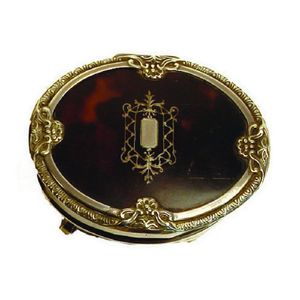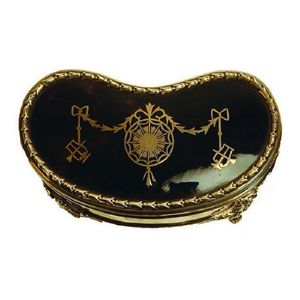George V Plique-à-Jour Dressing Table Box
You must be a subscriber, and be logged in to view price and dealer details.
Subscribe Now to view actual auction price for this item
When you subscribe, you have the option of setting the currency in which to display prices to $Au, $US, $NZ or Stg.
- Tortoiseshell - Tortoiseshell is a translucent material that comes from the horny carapace of a certain types of turtles, including the hawksbill turtle. It is often therefore mounted on a colour underground - often red - or inlaid with gold or silver thread, as seen in Boulle furniture.
The texture and colour nuances of the material are extremely important. Heated tortoiseshell can easily be formed into various shapes. Like other natural materials, tortoiseshell becomes more beautiful with use. In a time before plastic, tortoiseshell was widely used for small objects such as combs and powder compacts.
In 1973, the trade of tortoiseshell worldwide was banned under CITES (The Convention on International Trade in Endangered Species). Prior to importing or exporting items containing tortoiseshell a CITES permit must be obtained. Tortoiseshell items cannot be traded on Ebay.
"Faux tortoiseshell", another case of man initiating nature, is made from old-style plastics such as celluloid and cellulos and is coloured with red, yellow and brown spots to imitate the genuine article. It is commonly used in glasses frames, musical instruments and costume jewellery. - Plique-A-Jour - Plique a jour, which translates from the French as ?glimpse of daylight? is a method of enamelling in which the backing is removed or cut away so the light shines through, with a similar effect to a stained glass window. The enamel is held in place by border.
Although the technique of plique-a-jour has been known and in use since the 6th century, it became popular again in the late 19th century, in Russia and Scandinavia. Plique-a-jour was popular in the Art Nouveau period, especially for jewellery.
Because of the length of time required to produce an item, and the high failure rate, production was limited, and the technique is little used today. - Floral Swag / Garland / Festoon - Floral swags are a decorative motif often used in the ornamentation of various objects, such as silverware, glassware, and furniture. The term "swag" refers to a garland or wreath of flowers, foliage, or other decorative elements, which is usually arranged in a loop or curve.
Floral swags can be found in a variety of decorative styles, from ornate Baroque and Rococo designs to more naturalistic Art Nouveau and Art Deco styles. They are often used to add a touch of elegance, refinement, or whimsy to an object, and can be seen on a range of items from chandeliers and candlesticks to picture frames and tea sets.
In the decoration of silver objects, floral swags are often used to accentuate the curves and lines of the piece, and to add visual interest to the surface. Similarly, on glass objects, floral swags may be used to frame or highlight a particular area of the object, or to add a touch of color and delicacy.
On furniture, floral swags can be found on a variety of pieces, from cabinets and armoires to chairs and sofas. They are often used to enhance the lines and curves of the furniture, and can be used to create a sense of movement and flow in the design.
Overall, floral swags are a versatile decorative element that can be adapted to a range of styles and applications, and have been used in the decoration of various objects throughout history. - George V - George V (1865 ? 1936) was King of the United Kingdom and the British Dominions, and Emperor of India, from 1910 until his death in 1936.
This item has been included into following indexes:
Visually similar items

A George V silver plique-à-jour dressing table box, oval shape, the hinged lid inset with tortoiseshell, inlaid with a fine silver cartouche, raised on four scroll feet. Birmingham 1926. Width 7 cm

An early Victorian Japanese Shakudo gilt locket, circa 1890, two oval shape plaques inlaid with silver and gold shakudo work, one plaque depicting a Stork with two babies beneath bamboo and flowers, the other plaque depicting two pheasants beneath flowers

A gold locket. 9ct yellow gold, antique inspired as a cut cornered rectangular shaped locket of slender form, decorated to front panel with foliate work to surround, hinged to reveal two photo panels, fitted with bail. Length 3.8 cm

French Exhibition Medals: A collection including items for Paris 1855, Paris 1867, Paris 1875, Paris 1878, Paris 1879 (Science & Flight), Clermont-Ferrand 1880, Paris 1889, Tunis 1889, Saint Etienne 1891, Lyon 1894 & Paris 1904. (18 items; all different).
